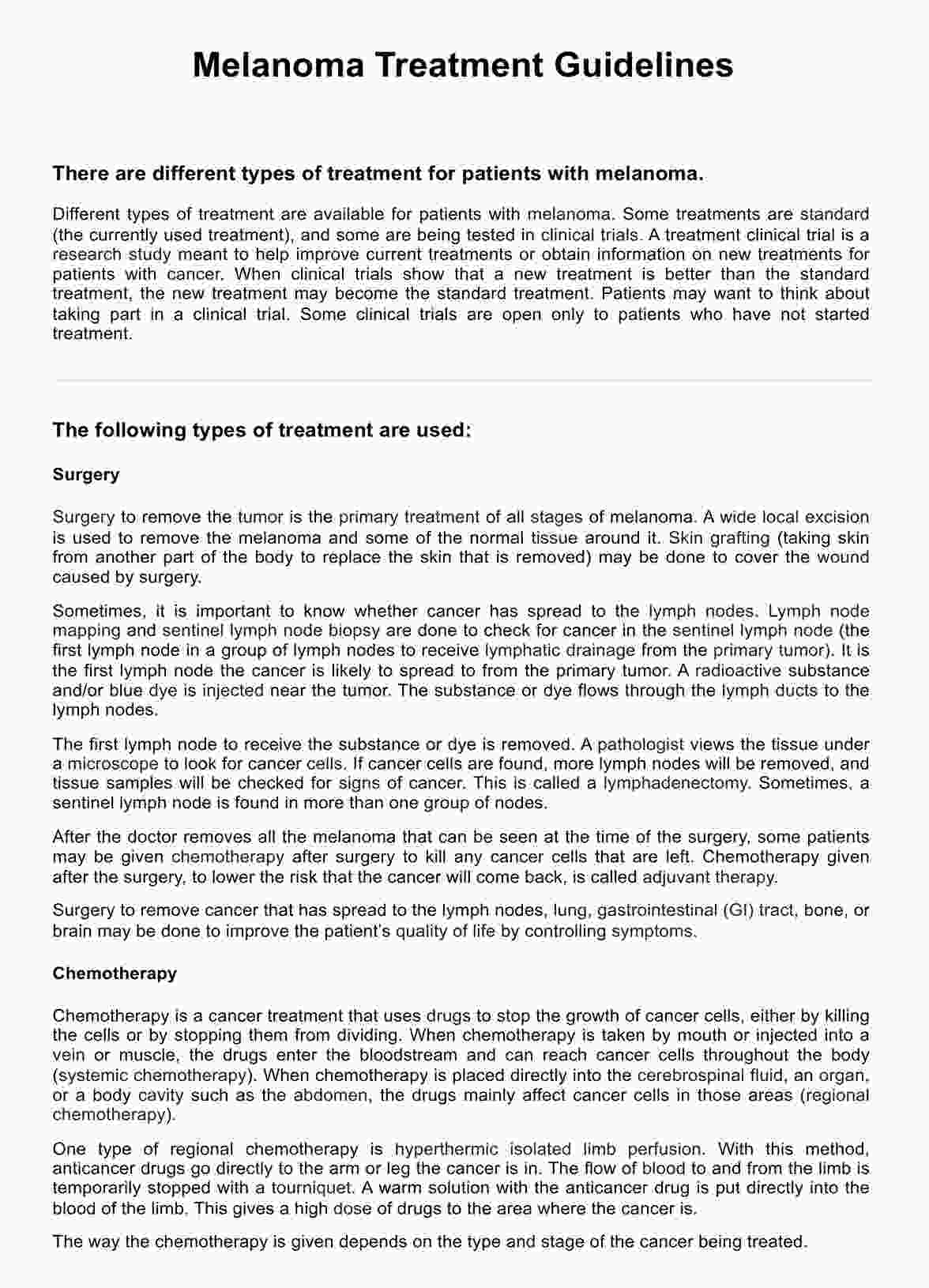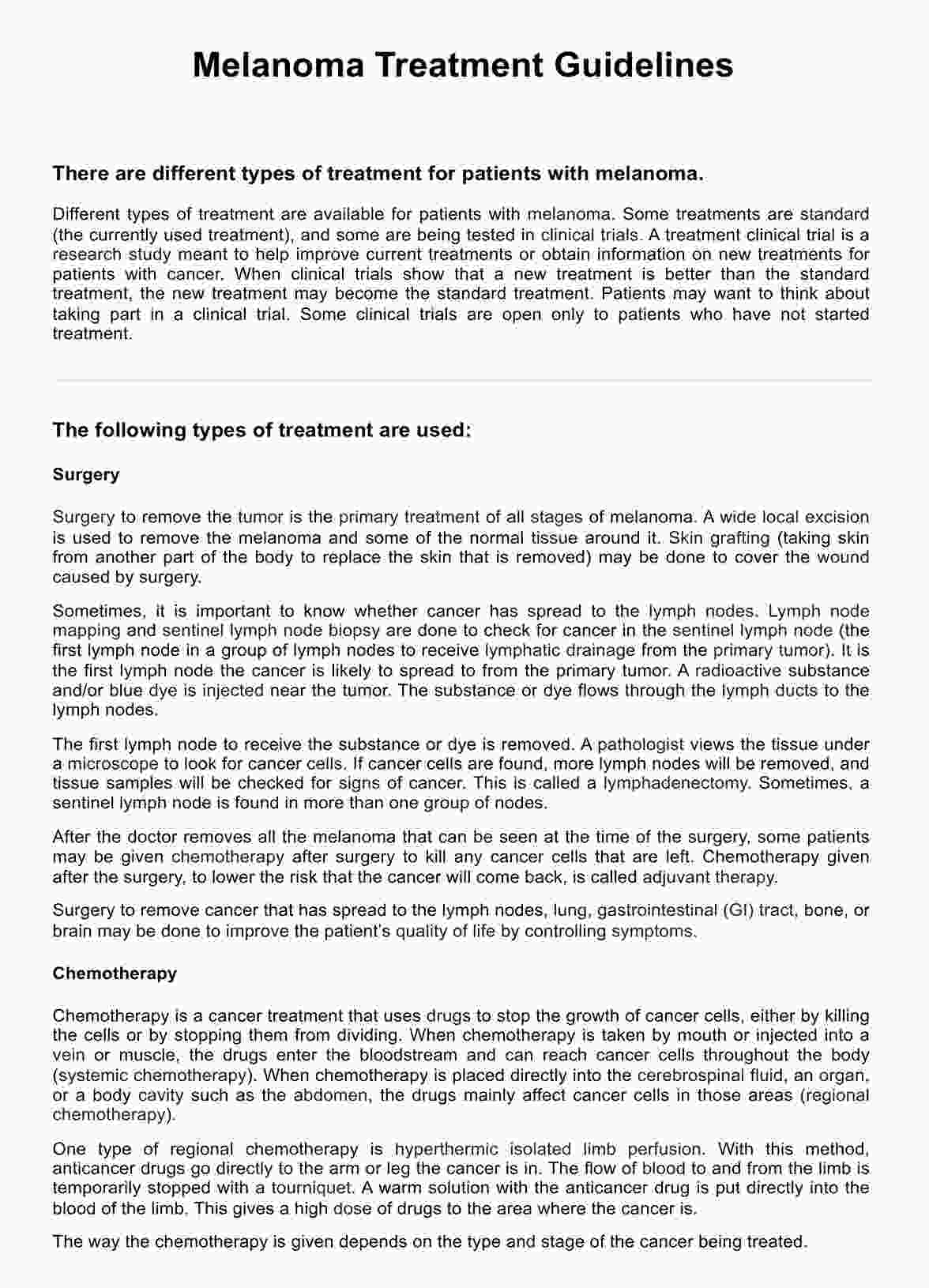Melanoma Treatment Guidelines Handout
Download Carepatron's free PDF handout and example on melanoma treatment guidelines to better understand the recommended treatment options for melanoma.


What is melanoma?
Melanoma is a type of skin cancer that originates in the pigment-producing cells called melanocytes. It is one of the most aggressive forms of skin cancer, with the potential to spread rapidly to other parts of the body if not detected and treated early.
Cutaneous melanoma, which arises from the skin, is the most common form of melanoma, but it can also develop in other parts of the body, such as the eyes or mucous membranes.
Patients with stage I or II melanoma typically undergo surgical removal of the primary tumor, often followed by sentinel lymph node biopsy to determine if the cancer has spread to nearby lymph nodes.
For those with resected Stage III melanoma, additional treatment options may include complete lymph node dissection or adjuvant therapy to reduce the risk of recurrence.
In cases of advanced metastatic malignant melanoma, where the cancer has spread to distant organs, treatment options may include immune checkpoint inhibitors, targeted therapy, radiation therapy, or participation in clinical trials.
Symptoms and signs of melanoma
Melanoma, a form of skin cancer, can manifest with various symptoms and signs. Recognizing these early indicators is crucial for timely diagnosis and treatment. Here are some common signs and symptoms of melanoma:
- Changes in moles: Keep an eye out for any changes in the size, shape, or color of existing moles.
- New moles: Be aware of the appearance of new moles on your skin, especially if they are asymmetrical, have irregular borders, or exhibit uneven coloring.
- Irregular borders: Melanomas often have irregular or poorly defined borders.
- Uneven coloring: Noticeable variations in color within a single mole or lesion can be a warning sign.
- Asymmetry: Melanomas may be asymmetrical in shape, meaning one half looks different from the other half.
- Large diameter: Moles or lesions larger than the size of a pencil eraser (about 6mm) should be monitored closely.
- Evolution: Changes in the appearance, size, or elevation of a mole over time should be evaluated by a healthcare professional.
It's important to remember that not all melanomas follow the ABCDE rule (Asymmetry, Border irregularity, Color variations, Diameter larger than a pencil eraser, Evolution), and some may exhibit atypical features. Regular skin self-examinations and annual dermatological screenings can aid in the early detection of malignant melanoma. If you notice any suspicious changes on your skin, consult a healthcare provider promptly.
Causes of melanoma
Melanoma can develop due to various factors, including genetic predisposition and environmental influences. Understanding the potential causes can help individuals take preventive measures and reduce their risk of developing this serious form of cancer. Here are some common causes of melanoma:
- UV radiation: Exposure to ultraviolet (UV) radiation from sunlight or tanning beds is a significant risk factor for cutaneous melanoma.
- Skin type: Fair-skinned individuals with light hair and eyes are more susceptible to cutaneous melanoma due to lower levels of melanin, which provides some protection against UV radiation.
- Family history: A family history of melanoma increases the risk of developing the disease, suggesting a genetic predisposition.
- Moles: The presence of numerous moles or atypical moles (dysplastic nevi) on the skin is associated with an increased risk of melanoma.
- Immune suppression: Individuals with weakened immune systems, such as those undergoing organ transplantation or living with HIV/AIDS, have a higher risk of developing melanoma.
- Previous history: Having a previous history of melanoma or other types of cancer increases the risk of developing additional melanomas.
Melanoma Treatment Guidelines Handout Template
Melanoma Treatment Guidelines Handout Example
How is melanoma treated?
Melanoma treatment strategies vary depending on factors such as the stage of the disease, whether it has metastasized, and the individual's overall health. Here's an overview of common treatment approaches:
Surgery for primary melanoma
Surgical excision is the primary treatment for localized malignant melanoma. This involves removing the tumor and a margin of healthy tissue around it to ensure complete removal. Sentinel lymph node biopsy may be performed to determine if the cancer has spread to nearby lymph nodes.
Adjuvant treatment for stage III melanoma
Patients with stage III may undergo adjuvant therapy after surgery to reduce the risk of recurrence. Adjuvant treatments may include immunotherapy, targeted therapy, or participation in clinical trials evaluating new therapies.
Treatment for metastatic melanoma
For metastatic disease (stage IV), treatment options depend on various factors, including the location and extent of metastasis. Immunotherapy, targeted therapy, chemotherapy, and radiation therapy are among the treatments used to manage advanced melanoma.
Management of recurrent melanoma
In cases of recurrent melanoma, treatment approaches may include surgery, radiation therapy, systemic therapy, or participation in clinical tests investigating novel treatment options.
Palliative care
For patients with advanced melanoma or previously untreated metastatic melanoma, palliative care focuses on symptom management and improving quality of life.
Commonly asked questions
The treatment protocol for melanoma typically involves surgical excision of the main tumor, followed by additional therapies such as adjuvant therapy, immunotherapy, targeted therapy, or radiation process, depending on the stage and extent of the disease.
The most effective treatment for melanoma depends on various factors including the stage of the disease, the presence of specific genetic mutations, and individual patient characteristics. Immunotherapy and targeted therapy have shown significant efficacy in treating advanced melanoma.
Chemotherapy is generally not the first-line treatment for melanoma. It is primarily reserved for patients with advanced meta static melanoma who have not responded to other treatment options such as immunotherapy or targeted therapy.







































































































